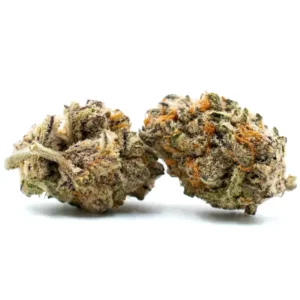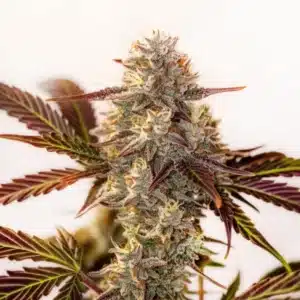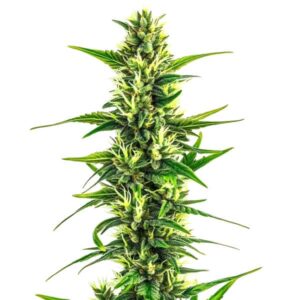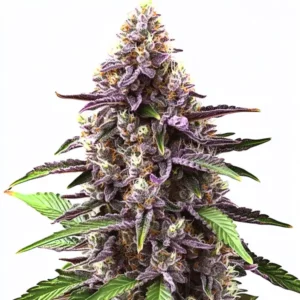
5 Marijuana Withdrawal Symptoms
First of all, we can say that prolonged use of cannabis or THC (tetrahydrocannabinol) can cause a dependency whose withdrawal syndrome will appear when its use is interrupted. This syndrome affects the brain system in conjunction with the amotivational syndrome, typical of continuous abuse or high doses of cannabis. These effects are commonly referred to as Marijuana Withdrawal Symptoms. Next, we will analyze what marijuana withdrawal syndrome is like and 5 of its main symptoms.
However, the withdrawal syndrome manifests itself with a series of symptoms that are different depending on the frequency and intensity with which the person consumed the weed. These weed withdrawal symptoms can appear as physical, emotional, and psychological reactions. Marijuana is a drug that causes alterations in the brain. That is why when consumption is stopped, a physiological response is created that is known as withdrawal from weed symptoms.
Recommended Strains
Apple Fritter THCA Flower
-
THCA: 22% - 25%
-
Type: THCA
-
Phenotype: 40% Sativa / 60% Indica
-
Aroma: Apple, Candy, Vanilla
Gelato THCA Flower
-
THCA: 25% - 27%
-
Type: THCA
-
Phenotype: 40% Sativa / 60% Indica
-
Aroma: Fruity, Nutty, Vanilla, Mint
This response will vary in intensity depending on the person’s level of dependency and will present itself through physical and psychological thc withdrawal symptoms. Not everyone who stops using marijuana will have to experience withdrawal symptoms from thc. However, its symptoms are much more likely to appear the longer this drug has been smoked. If we compare it with other substances such as alcohol or cocaine, the severity of the symptoms of cannabis is not great. In the same way, the intensity of these will be different between people. Someone with a very low dependence on marijuana may have no symptoms or they may be so mild that they can manage them on their own.
It is good to know what symptoms users experience when they suffer withdrawal syndrome which is why we are going to give you a guide so that you can distinguish the main symptoms.
Headache: Headache can last for 1 or 2 weeks, manifesting itself as a symptom of cannabis withdrawal symptoms. Headaches start 3-4 days after stopping marijuana use.
Anxiety and depression: Some people can feel a great lack of motivation when they stop consuming ganja and even phases of sadness and paranoia. This can be combated with techniques such as meditation.
Flu symptoms: Some users feel chills and body sweating and even fever when they are experiencing withdrawal symptoms.
Sleeping problems: Some users who stop using cannabis all at once present symptoms of insomnia and sleep disorders. Also, sweating in bed and extreme nightmares are present in these cases.
Irritability: At the beginning of withdrawal, one of the first symptoms that stands out is irritability or anger which can start in a mild way and then end with more intense effects of fury.
The situation of withdrawal syndrome
Recently, one of the published studies indicated that around 47 % of cannabis consumers experience Marijuana Withdrawal Symptoms, a figure that varies according to the type of cannabinoids they have consumed. It is important to emphasize that many people are unaware of the phenomenon of withdrawal; therefore, they may suffer from this syndrome without realizing it, as the researchers point out. Consequently, individuals who turn to cannabis for medicinal purposes can ultimately find themselves caught in a loop of self-medication, dependence, and pot withdrawal.
However, the results of this study are not conclusive because it is a meta-analysis, that is, it includes many studies that are considered similar enough to draw strong conclusions despite including studies dating back to the mid-1990s, a time when cannabis was illegal in the US, had a different potency, and there was no choice or control over strains or cannabinoid compositions like there is now.
Promos & Deals
Amotivational Syndrome
Marijuana Withdrawal Symptoms often include the so-called “amotivational syndrome,” a state marked by difficulty feeling pleasure beyond marijuana use. This syndrome affects memory, attention span, emotions, and overall motivation. The longer the weed consumption has been, the stronger this sense of general apathy becomes. In addition, amotivational syndrome is linked to a range of Marijuana Withdrawal Symptoms that impact both emotional regulation and executive functions.
Some symptoms of amotivational syndrome can be summarized as follows:
1- Difficulty making decisions.
2- Trouble setting goals.
3- Lack of motivation to do things.
4- Losing interest in work or school.
5- Not assigning importance to people or things. Showing passivity.
6- Difficulty finishing tasks.
7- Not paying attention to the consequences of the actions that are carried out. Showing indifference.
8- Lack of interest in what requires effort. Neglect towards oneself.
9- Problems with concentration and attention.
10- Lack of interest.
11- Not being aware of the state one is in. Inability to be introspective.

Management of withdrawal syndrome
Below, we present the main steps to better manage abstinence and also to prevent it.
1– Stay hydrated: Drink plenty of water and avoid sugary and caffeinated beverages like sodas. The objective providing your with a good dose of water.
2- Eat healthy food: Take advantage of eating fruits and vegetables in large quantities. Lower your consumption of red meat and fried foods. Avoid junk food like French fries, hamburgers, pizzas, among others because they can make you feel sluggish and irritable.
3- Exercise: At least 30 minutes of exercise every day is necessary. Being physically active helps improve your mood and helps eliminate toxins as you sweat.
4- Create a circle of support: Between your family, friends, and people who know you and can give you a hand. A close circle of help is one of the main supports among cannabis users when they feel withdrawal symptoms.
Duration of withdrawal syndrome
The duration of the different phases of Marijuana Withdrawal Symptoms depends on each person, which is why it is helpful to have a clear chronological reference. The worst effects are said to pass during the first two weeks after stopping regular weed use.
Week 1:
In this first week, you can visualize and experience symptoms such as physical and mental fatigue. People often get irritated and then anxiety attacks and trouble sleeping begins.
Week 2:
During this week, the withdrawal symptoms are at their peak. Here, people will start experiencing headaches and flu-like symptoms.
Week 3:
In this week, the person with these symptoms feels relief. This happens because the discomfort begins to disappear, although you must be careful because the symptoms can return.
Week 4:
Sure you won’t feel it at first, but the cannabinoid receptors in your brain will be relieved.
Physical effects of withdrawal syndrome
When we talk about the physical symptoms of marijuana withdrawal, it should be clear that they are less intense and peak earlier and disappear more quickly than the psychological symptoms associated with quitting smoking. Also, these effects will depend on the amount of marijuana that was consumed before quitting.
– Stomach ache
– Changes in appetite
– Weight loss or gain
– Flu-like symptoms such as headache, sweating, shaking, fever, and chills
Psychosis effect of withdrawal symptoms
A 2017 study says long-term marijuana use can produce “mild to moderate” withdrawal symptoms which affect a person’s mood and behavior. Also, In the worst case, outpatient medical care may be needed, but that’s about it. Furthermore, there is no evidence to confirm that cannabis causes such mental disorders. In reality, the only time someone might need hospital care due to marijuana use or withdrawal would be if that person had a pre-existing mental disorder. Even then, in some cases, comprehensive outpatient care would suffice.
For cannabis withdrawal to go away completely, you will need to refrain from using marijuana and virtually any other stimulant substance. So, for example, if you replace cannabis use with tobacco and alcohol, it is very likely that your situation will worsen and you will probably end up using marijuana at the same rate as before.
You already know everything you need to know about abstinence and Marijuana Withdrawal Symptoms. In case you need extra help, do not hesitate to consult a specialist who will guide you in your abstinence process. Remember that it is always good to use cannabis and any type of substance responsibly. Therefore, if you have problems with withdrawal or abuse of consumption, it is better that you change your habits.

FAQs About Marijuana Withdrawal Symptoms
What are the most common Marijuana Withdrawal Symptoms?
The most frequently reported Marijuana Withdrawal Symptoms include headaches (often starting 3–4 days after quitting), anxiety or depressed mood, irritability, insomnia with vivid dreams or night sweats, and flu-like effects such as chills or fever. The exact mix and intensity vary by how long and how heavily a person has used cannabis.
How long do Marijuana Withdrawal Symptoms usually last?
For most people, the worst discomfort peaks during the first two weeks after stopping regular use:
| Phase | Typical Experience |
|---|---|
| Week 1 | Fatigue, irritability, anxiety, and early sleep problems |
| Week 2 | Peak symptoms: headaches, flu-like aches, and stronger mood swings |
| Week 3 | Noticeable relief as both physical and emotional symptoms ease |
| Week 4 | Brain cannabinoid receptors begin to reset; lingering symptoms are mild |
Individual timelines differ, but severe symptoms rarely extend past a month.
How can I manage Marijuana Withdrawal Symptoms effectively?
To reduce the intensity and duration of Marijuana Withdrawal Symptoms:
- Stay hydrated – drink plenty of water and avoid excess caffeine or sugary drinks.
- Eat a balanced diet – focus on fruits, vegetables, and lean proteins; cut back on junk food.
- Exercise daily – even 30 minutes of walking or light cardio improves mood and speeds toxin clearance through sweat.
- Build a support circle – share your goal with friends, family, or a counselor who can help if cravings or anxiety spike.
- Seek professional help when needed – a physician or addiction specialist can guide you through severe withdrawal or underlying mental-health issues.
Implementing these habits not only eases current symptoms but also lowers the chance of relapse.



















